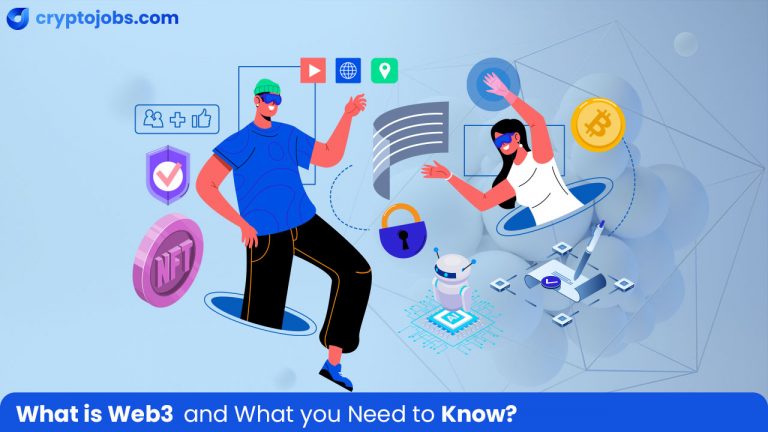
What is Web3? Why it Matters and What You Need to Know!
- cryptojobs.com
- December 4, 2023
- All Posts, Web3
- Web3
- 0 Comments
Web3 has the potential to disrupt the online world and redesign the whole internet. And this revamp promises to put the power in the hands of the people, as opposed to big corporations. Web3 aims to revolutionize the way users interact with the internet. As this revolution begins to take its course, it is important to understand why it matters and what the future holds for the online experience.
What is Web3 – Understanding Web1 and Web2
To understand Web3, it is essential to grasp the concepts of Web1 and Web2.
Web1, often referred to as the ‘Static Web’ or the ‘Read-Only Web’ was a phase where the internet primarily served as a platform for information consumption. Websites offered limited interactivity – users could access content but contributing to it was minimal.
Web2, widely known as the ‘Social Web’ came around in the early 2000s. This phase of the internet saw the emergence of various social media platforms and increased user engagement.
Web3, the current and continuously evolving phase of the internet is characterized by a decentralized and trustless web, powered by blockchain technology. Web3 aims to empower users with ownership of their data, reduce reliance on central authorities, and enhance privacy.
Important Features of Web3
Backed by Blockchain
At the heart of Web3 is blockchain, which is the distributed ledger technology used by cryptocurrencies like Ethereum and Bitcoin. The main feature of Web3 is that it is not controlled by a central authority allowing for more transparency, security, and immutability. This creates a truly trustless environment where users can interact with each other without intermediaries.
Ownership and Control
One of the most revolutionizing features of Web3 is the shift in ownership and control. Thanks to blockchain, users genuinely own their data and have a lot more control over how it is used. This is different from the highly centralized internet that we use today where most of the sites and their data is owned by a few major corporations. Since Web3 platforms are powered largely by blockchain-based infrastructures, no central authority is in charge and users can easily interact with each other without any interference.
Smart Contracts
Smart Contracts are self-executing contracts stored on a blockchain based on if-then-logic, which means that they would automatically run when certain predetermined conditions are met. These contracts are executed without any third-party intervention, enabling a trustless and decentralized system, which is transparent and efficient.
Advanced AI Algorithms
Artificial Intelligence is not inherently Web3 and is currently deployed on Web2, but it will soon have a major role to play in the Web3 ecosystem. Web3 and AI together can help develop a framework where applications and platforms would be able to operate on a decentralized and transparent backbone along with having the power to think, adapt, and provide intelligence-driven services, creating a more responsive and integrated digital ecosystem.
Connectivity and Ubiquity
Web3 is a borderless and seamlessly interconnected digital landscape that would allow users and devices in the ecosystem to stay connected at all times. The idea that ‘Web3 never sleeps’ is one of the most essential differentiating factors between Web2 and Web3. Connectivity is made possible in Web3 with decentralized networks, interoperability, and smart contracts.
Ubiquity, the idea of being everywhere is also ensured by the decentralized nature of Web3. With nodes spread across the world, the possibility of downtime or regional disruptions is quite low. In addition to that, edge computing, which is a growing trend in Web3 has bridged the gap between computation and data sourcing, enhancing the user experience and making applications more responsive.
Web3 and the Metaverse
Web3 technologies are inherently linked with the development of the metaverse since they will enable users to transact and interact with each other in the metaverse environments. For instance, blockchain and NFTs, which are both Web3 technologies, will allow users to own and trade digital assets in the metaverse. These digital assets could include digital art, digital land, or even digital accessories!
The monetary system in the metaverse will be most likely cryptocurrency since it belongs to the same framework and is stored on a blockchain. The true potential of the metaverse can only be realized with the use of Web3 technologies.
NFTs and Web3
NFTs or Non-Fungible Tokens have been making headlines for quite a while now. These are basically digital tokens that are stored on a blockchain and represent the ownership of assets. NFTs cannot be replicated or counterfeited and cannot be exactly equal to another NFT either. Their primary use is ownership of digital art, collectibles, and gaming. Emerging use cases for NFTs include the tokenization of physical assets such as art and real estate. In other words, NFTs are beginning to have a lot more real-world utility – certainly more than just trading jpegs of cartoon animals!
You may like: » Tips to Become a Successful NFT Artist for Beginners
What are the Risks and Pitfalls of Web3?
Web3 proposes a complete revamp of the internet – and as with anything this complex and extensive, there are bound to be risks involved. Let’s look at some of the most likely issues that could arise with the transition to Web3.
Regulation
While arguments have always existed around how good Web3 job regulatory bodies are doing, they have generally been able to protect internet users from being subjected to issues like hacking, theft, harassment, and fraud. Some believe that with the individualization of all internet users, these problems could increase, along with the addition of entirely new ones. The main reason behind this is the anonymous nature of Web3’s underlying framework. Cryptocurrency, for example, has been used to support criminal activity in the past by providing a completely anonymous mode of payment that is not restricted by any government or central authority.
However, as with any tool, it is all about the people that use it. For instance, people living in repressive regimes could benefit greatly from the use of cryptocurrency and its anonymous nature.
Environmental Effects
One of the biggest complaints about blockchain technology has been its impact on the environment due to a process called ‘mining’. Cryptocurrency and blockchains rely on huge banks of processors to handle the massive workload of decentralized operations. These devices have a massive impact on the local grid and can become a huge drain on them, which is why alternatives need to be created. Ethereum, for instance, is attempting to move away from the process of mining entirely. However, this would drastically reduce the production of ether and pose other challenges.
You may like: Jobs in Crypto 101 – The Ultimate Guide
Security
Web3 is widely understood to be quite safe, but it is important to remember that ultimately, all online security relies on one frail factor: human beings. The keys to the tokens that power Web3 will be in the hands of each user. Even if one of these users can be pulled into a phishing scam, they could potentially expose themselves to identity theft and fraud.
Web3 truly has massive potential but to achieve mass adoption and long-term sustainability, it is very important to address these uncertainties and hurdles.
The Road Ahead with Web3: Adoption and Impact
The era of Web3 is here and is unfolding right before our eyes. As the technological advances in decentralization mature, different industries ranging from finance to healthcare and entertainment are likely to undergo transformative changes. Web3 will, sooner or later, democratize access to information, data, finance, and opportunities.
Conclusion: Embracing the Web3 Era
Web3 is not simply a technology change – it is a paradigm shift in the way we perceive and engage with the online world. It is a reimagination of the Internet as a largely user-driven and decentralized ecosystem. As more and more organizations enter this space, one thing is clear – Web3 is not just the future, it is the present and we can all be a part of actively shaping the next generation of the internet.
Web3 is a rapidly growing field of technology and it is an ideal time to embrace it on a professional level. If you are planning a career switch from Web2 to Web3, don’t forget that a reliable Web3 job board like cryptojobs.com can make the transition easier by helping you find the right job opportunities.
Web1 (90’s) was static while Web2 (2000s to present) integrated interactions into the internet. Web3 is the current move towards a more decentralized and autonomous era of internet, which is more user-centric and is powered by blockchain.
In Web3, users truly own their data, shifting the control from centralized authorities and platforms to individuals using blockchain technology.
One of the key features of Web3 tokenomics is the ability to create and distribute tokens in a decentralized manner. This process is referred to as Initial Coin Offering (ICO) and allows startups to raise capital without having to go through the typical fundraising channels.
Blockchain is a distributed ledger technology that helps ensure transparency, security and immutability. It is the foundational technology behind decentralized applications (dApps) and smart contracts.
Smart contracts are self-executing contracts powered by blockchain. They are used to automate agreements without the need for intermediaries.
DeFi (Decentralized Finance) is a blockchain-based alternate to traditional financial services. In DeFi there are no intermediaries and users can get direct access to financial services through the use of smart contracts.




